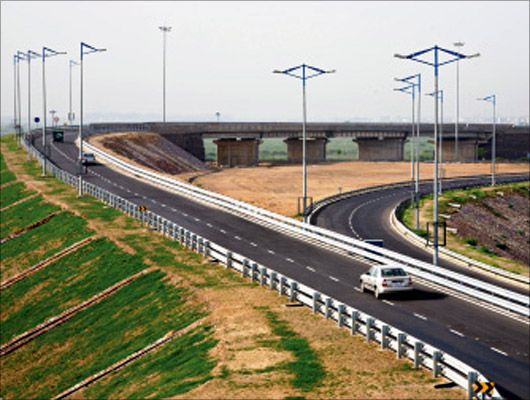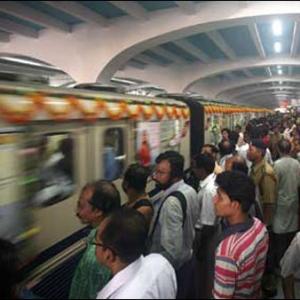The public-private-partnership model for infrastructure may benefit from reversing the financing sequence, notes Subir Gokarn.

A look at how businesses have traversed the path between start-up and the stock market over the past few decades clearly indicates a transition process that can aptly be described as a "capital ladder".
Each step in the ladder is increasingly being provided by specialised entities, which have developed the capabilities best suited to that particular step.
I believe this approach is a useful way to address the problems of India's infrastructure. Let me identify five steps in the capital ladder - angel, early-stage venture, late-stage venture, private equity and public equity.
We're all very familiar with these steps in the context of technology sectors, but the fact is that, in one form or another, every business needs to climb the ladder.
For less esoteric activities - garments or footwear, for example - the lower steps of the ladder may not be provided my marquee names, but family and friends, often an extended kin or community group, play just as important a role.
Regardless of the entity associated with a particular step, the key differentiating factor between them is the level of risk intrinsic to each step.

The reason why entities tend to specialise with respect to one or perhaps two steps is that to survive, they have to develop the capabilities to assess risk and buffer themselves against it.
Associated with different levels of risk is the capacity to leverage equity by taking on debt. Obviously, the lower the step, the greater the risk and the lower the capacity to leverage.
If you want to start up a business, you would almost never "borrow" money in the strictest sense of the term.
However, when we look at how infrastructure projects evolve, it may appear that they are exceptions to the ladder rule.
Typically, infrastructure is a high-leverage business - debt-equity rations are higher than for most other businesses - because of the relative predictability and stability of earnings.
I'll come back to this point later; the key question here is whether the steps in the ladder can somehow be bypassed when an infrastructure project is initiated.

\
India's public-private partnership (PPP) tried this bypass. In return for a guarantee on cash flows, private promoters were expected to put in their equity and then leverage it heavily by borrowing from whoever was willing to lend to them - in this case, banks.
The assumption clearly was that project execution timelines would be adhered to and revenues would flow in as scheduled.
With this level of certainty, servicing bank loans would not be difficult; when the time came, banks could unload their exposures to other investors with longer horizons, whose returns would come from earnings out of operations.
But as experience showed us, risk assessment in new projects can be tricky.
Real life was a far cry from the assumptions about flawless execution and on-schedule completion.

The tribulations that infrastructure projects typically went through brought into the picture a set of risks that the funding model simply could not accommodate.
Bottlenecks everywhere, leading to delays, increasing costs and pushing the prospect of earnings further and further away.
With this risk profile, the capital-ladder framework would have suggested that taking on so much debt at the beginning of the venture was inadvisable.
Better to find other means of finance, with a different risk appetite coming into play as the project went through stages of execution and gradually approached its full operational phase.
This seems like a reasonable proposition, except when one asks: are there, in fact, entities who would facilitate the early steps of the capital ladder for infrastructure, like they do for technology or e-commerce companies?
Or will the sheer scale of each project and the time taken for each step deter them?
The prudent answer to these two questions are: no and yes.
The ability to fund infrastructure in the way that other businesses are typically funded just doesn't seem to be there.

This is not unique to India, as the long history of multilateral, regional and national financial institutions will attest to.
To the extent that countries have had success with setting up adequate infrastructure, it is not by bypassing the lower steps of the capital ladder.
Rather, it is by creating a set of institutions that played appropriate roles in the process.
While the specifics of the model may have varied across countries and over time, the common feature seems to be that the government, either directly or indirectly, absorbed the risks inherent in the early stages of infrastructure projects. In the Indian context, these risks have proved to be significant and will, in all likelihood, remain so.
Procedural and decision-making streamlining will help contain, but not eliminate them.
As much as we are tempted to take the government out of infrastructure investment, our PPP experience sends out a very strong message that it just will not work that way.
The government may play little or no role in project execution, but it must resume its role as the primary source of financing in the early stages of a project.
In terms of the five-step ladder, this comprises the first three stages. All said and done, there is no greater capacity in the system to absorb risk than in the government.
Public funds may often be used inefficiently, but if this is guarded against, they can make the difference between functional and dysfunctional infrastructure programmes.
Based on this reasoning, in the early stages of the process, PPP needs to be a combination of public funding and private execution. It is only at a later stage - the last two steps on the capital ladder - that private funding becomes viable.
Proximity to the beginning of the revenue stream for the project - the predictability and stability that I alluded to earlier - is the determinant for effective entry of private financing into the process.
Just as the entities associated with the each successive step of a capital ladder make their money by selling their stakes to the entities specialising in the next step, public funding of infrastructure can, at an appropriate time, sell stakes in projects to private entities, using the money thus made to finance new infrastructure projects.
And so on. To give the concept clarity, PPP should perhaps be re-labelled FPTP - First Public, Then Private.
(Subir Gokarn is the director of research, Brookings India, and former deputy governor, Reserve Bank of India.)










